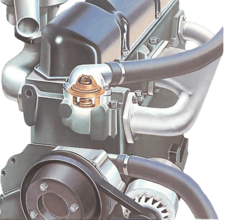Thermomètre
A thermometer is a device that measures temperature or a temperature gradient using a variety of different principles. A thermometer has two important elements: the temperature sensor (e.g. the bulb on a mercury-in-glass thermometer) in which some physical change occurs with temperature, plus some means of converting this physical change into a numerical value (e.g. the visible scale that is marked on a mercury-in-glass thermometer).
Operating principles of thermometers include the thermal expansion of solids or liquids with temperature, or the change in pressure of a gas on heating or cooling. Radiation-type thermometers measure the infrared energy emitted by an object, allowing measurement of temperature with out contact.
Thermometers are widely used in industry to control and regulate processes, in the study of weather, in medicine, and scientific research.
Some of the principles of the thermometer were known to Greek philosophers of two thousand years ago; by the 18th century, standardized scales allowed the readings of different thermometers inter-comparable.
Read more on Wikipedia
Cet outil est utilisé dans
If the engine warms up very slowly, or never reaches normal temperature, or if it overheats quick...

